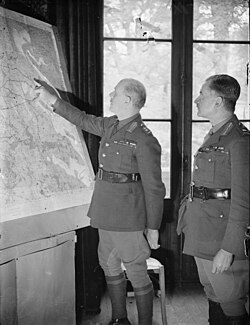- GHQ-attached units
- 2nd Field Security Police Section Corps of Military Police
- 6th Field Security Police Section Corps of Military Police
- 30th Field Security Police Section Corps of Military Police
- 33rd Field Security Police Section Corps of Military Police
- General Headquarters Signals, Royal Signals
- 2nd Wireless Company, Royal Signals
- 100th Special Wireless Section (Providing support for GHQ)
- 101st Special Wireless Section (Providing support for I Corps)
- 102nd Special Wireless Section (Providing support for II Corps)
- 103rd Special Wireless Section (Providing support for III Corps)
- 1st Air Formation Signals, Royal Signals
- 2nd Air Formation Signals, Royal Signals
- 1st Air Liaison Signals Section Royal Signals
- 4th Air Liaison Signals Section Royal Signals
- 6th Air Liaison Signals Section Royal Signals
- 7th Air Liaison Signals Section Royal Signals
- 12th (The Prince of Wales's) Royal Lancers
- 1st Battalion, Welsh Guards
- 7th Battalion, Cheshire Regiment (Machine-Guns)
- 14th Battalion, Royal Fusiliers (City of London Regiment) (company size) - garrison unit
- 8th Battalion, Middlesex Regiment (Duke of Cambridge's Own) (Machine-Guns)
- 9th Overseas Defence Battalion, West Yorkshire Regiment (Prince of Wales's Own) - garrison unit
- 6th (Argyllshire) Battalion, Argyll and Sutherland Highlanders (Princess Louises's Own) (Machine-Guns)
- 6th Battalion, King's Own Royal Regiment (Lancaster) (Pioneers)
- 7th Battalion, King's Own Royal Regiment (Lancaster) (Pioneers)
- 8th Battalion, King's Own Royal Regiment (Lancaster) (Pioneers)
- 6th Battalion, South Staffordshire Regiment (Pioneers)
- 5th Movement Control Group Royal Engineers
- 2nd Advanced Medical Depot, Royal Army Medical Corps
- 4th Advanced Medical Depot, Royal Army Medical Corps
- 9th Field Hygiene Section, Royal Army Medical Corps
- 2nd Casualty Clearing Station, Royal Army Medical Corps
- 3rd Casualty Clearing Station, Royal Army Medical Corps
- 9th Casualty Clearing Station, Royal Army Medical Corps
- 11th Casualty Clearing Station, Royal Army Medical Corps
- 13th Casualty Clearing Station, Royal Army Medical Corps
- 4th Motor Ambulance Convoy, Royal Army Medical Corps
- 5th Motor Ambulance Convoy, Royal Army Medical Corps
- 6th Motor Ambulance Convoy, Royal Army Medical Corps
- 8th Motor Ambulance Convoy, Royal Army Medical Corps
| - Headquarters, G.H.Q. Troops, Royal Army Service Corps
- 1st G.H.Q. Troops Company, Royal Army Service Corps
- 2nd G.H.Q. Troops Company, Royal Army Service Corps
- 3rd G.H.Q. Troops Company, Royal Army Service Corps
- 1st Lines of Communication Railhead Company, Royal Army Service Corps
- 2nd Lines of Communication Railhead Company, Royal Army Service Corps
- 2nd Supply Personnel Company, Royal Army Service Corps
- 3rd Petrol Depot, Royal Army Service Corps
- 1st Troop Carrying Company, Royal Army Service Corps
- 2nd Troop Carrying Company, Royal Army Service Corps
- 3rd Troop Carrying Company, Royal Army Service Corps
- 4th Troop Carrying Company, Royal Army Service Corps
- 9th Troop Carrying Company, Royal Army Service Corps
- 13th Troop Carrying Company, Royal Army Service Corps
- 14th Troop Carrying Company, Royal Army Service Corps
- 1st Motor Transport Works Services Company, Royal Army Service Corps
- 2nd Motor Transport Works Services Company, Royal Army Service Corps
- 3rd Motor Transport Works Services Company, Royal Army Service Corps
- 4th Motor Transport Works Services Company, Royal Army Service Corps
|

